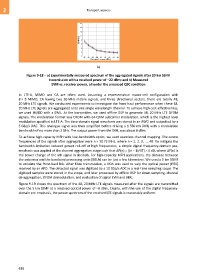Page 626 - 5G Basics - Core Network Aspects
P. 626
2 Transport aspects
b)
Figure 9-18 – a) Experimentally measured spectrum of the aggregated signals after 20 km SSMF
transmission with a received power of –22 dBm; and b) Measured
EVM vs. receiver power, all under the proposed QSC condition
In LTE-A, MIMO and CA are often used. Assuming a representative macro-cell configuration with
8 × 8 MIMO, CA having two 20 MHz mobile signals, and three directional sectors, there are totally 48,
20 MHz LTE signals. We conducted experiments to investigate the front-haul performance when these 48,
20 MHz LTE signals are aggregated onto one single wavelength channel. To achieve high cost-effectiveness,
we used IM/DD with a DML. At the transmitter, we used offline DSP to generate 48, 20 MHz LTE OFDM
signals. The modulation format was OFDM with 64-QAM subcarrier modulation, which is the highest level
modulation specified in LTE-A. The time-domain signal waveform was stored in an AWG and outputted by a
5 GSa/s DAC. This analogue signal was then amplified before driving a 1 550 nm DML with a modulation
bandwidth of no more than 2 GHz. The output power from the DML was about 8 dBm.
To achieve high-capacity MFH with low-bandwidth optics, we used seamless channel mapping. The centre
frequencies of the signals after aggregation were n × 30.72 MHz, where n = 1, 2, 3, ..., 48. To mitigate the
bandwidth-limitation induced power roll-off at high frequencies, a simple digital frequency-domain pre-
emphasis was applied at the channel aggregation stage such that P(n) = [(n − 1)/47] × 4 dB, where P(n) is
the power change of the nth signal in decibels. For high-capacity MFH applications, the distance between
the antennas and the baseband processing units (BBUs) can be just a few kilometres. We used a 5 km SSMF
to emulate the front-haul link. After fibre transmission, a VOA was used to vary the optical power (PRX)
received by an APD. The detected signal was digitized by a 10 GSa/s ADC in a real-time sampling scope. The
digitized samples were stored in the scope, and later processed by offline DSP for down-sampling, channel
de-aggregation, OFDM demodulation, and evaluation of signal EVM and BER.
Figure 9-19 shows the spectrum of the 48, 20 MHz LTE signals measured after the signals are transmitted
over the 5 km SSMF at a received optical power of −6 dBm. Clearly, with the use of the digital frequency-
domain pre-emphasis, the power spectrum of the received LTE signals is reasonably uniform.
616

